The Science and Faith columnist of the Catholic Peace Weekly gives readers a meditation on eyes and what they can teach us.
Why do humans have two eyes? Science books say they give us a sense of perspective and depth. But this doesn't explain why we have two eyes; it's the consequence.
The advantages of having two eyes are clear. The angle that forms between your eyes and an object is called the optical angle, and depending on the size of the angle, your brain recognizes whether the object is far or near. The angle between our eyes and the ends of the object of sight, the visual angle, gives you a three-dimensional sense of the object's size. While the eyes are sensors that receive light stimuli and allow us to detect the shape and color of objects and determine their location, not all animal eyes perform as many functions as human eyes.
For example, underwater, distant objects are difficult to see, and most fish can only see close objects and don't have color-sensitive cells in their eyes. Frogs, snakes, and reptiles also have imperfect eyes that rely on other senses to identify prey and distinguish colors. Birds can see five to ten times farther than humans, which is related to their survival requirements of flying and foraging at high altitudes.
Dogs cannot distinguish red and have vision blindness similar to human red-green color blindness. Still, their excellent sense of smell and hearing compensates for their eyes' imperfections. Only humans and some primates, such as chimpanzees, can see the many colors in nature. They use their eyes to perceive perspective and grasp the size of objects.
However, despite having more developed eyes than other animals, humans often fail to adjust their inherent perspective on the world and other people. There are things in the world that can only be seen properly from a distance, and conversely, there are things that can only be seen up close and with attention. We need to get as close as possible to our inner selves, reflect on all, and step back from the faults of others and the events of the world to see the big picture.
The columnist goes to a watercolor class once a week. He often wonders if he's getting the color right in his sketchbook. His art teacher often says, “You can't see it up close; try looking at it from a little further away.” He is reminded of what that means these days. He needs perspective on the world and others and spiritual vision.
In this week's Gospel for the Fifth Sunday of Lent, the scribes and Pharisees insist that a woman caught in sin should be stoned to death. When Christ says, “Let him who is without sin among you be the first to throw a stone at her” (John 8,7), “when they heard this, they went away one by one, starting with the older ones” (John 8,9).
We must adjust our perspective and look closely at ourselves before condemning anybody. When did we lose the vision of the mind's eye, seeing things too close and too big when they should be seen at a distance and seeing things at a distance we should see close. We must remember this when tempted to use unkind words and easily angered by others.

No comments:
Post a Comment